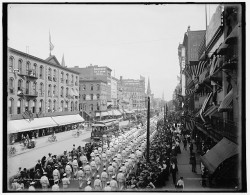
Labor Day in the U.S. is almost here. Many other countries also celebrate a labor day, which has always seemed an unusual event to me. We didn’t celebrate such a day at all until Tuesday, September 5, 1882, in New York City. Interestingly, this is a date that coincides well with the world’s entry into the impersonal and mechanistic 20th century.
I have been noodling for quite some time over the work/life balance movement. I call it a movement because it really came about unexpectedly around 15 years or so ago and has swept corporate America from coast to coast.
I can’t think of any organization that has not had to change policies or at least address its employees about the issue. The work/life balance movement is an interesting phenomenon. I don’t think there has been a previous era when there was such an emphasis on specifically setting aside time for non-work activities.
It is a logical outcome of decades of isolating work from other aspects of life. The idea of creating a balance is based on a set of assumptions that aren’t questioned, yet are very strange from the perspective of a Baby Boomer such as myself or from that of anyone who has studied the history of work.
Assumptions About Work
If I were to state the assumptions, they would go something like this: Work is something we do for money, is generally not very enjoyable and interferes with more important things like family.
We should be required to spend as little time as possible “at work” as it interferes with things we would rather be doing. It also subtly assumes that we all must be physically at some other place than home when we work.
The end result is a belief that work should be regulated and time with our families should be made mandatory. The work/life balance cause assumes a more or less digital world: work is on or off, family/life is on or off. For them it seems strange or impossible to have work you get paid for that is your life.
History of Work
Yet, for centuries work and life were co-joined. It is only in the past century that we have physically separated most paid work from the home.
Throughout all of history people have toiled in fields, worked in small shops, bazaars and at home without paychecks, labor laws, or a day off. Women and men shared skills and children were almost always part of the working and life equation as soon as they were old enough. Work might not have been fun in our modern sense, but it was a family activity and it was the fabric of life. Hobbies, travel, and other pleasurable activities were limited by the call of nature and the needs of the community.
Many people ended up doing things that were not of their choosing, but were inherited from fathers or were available at the time they were looking. The classic global example is that of the farmer. On every farm the entire family participated from an early age in the work. Even learning was a family activity, and fathers and sons often co-invented things or passed their knowledge to each succeeding generation.
The modern separation of work from family, learning, and pleasure was the result of the economic expediency found in isolating work in factories and offices. By overseeing the work, owners could ensure efficiency and focus and over the past century has led to increasing levels of work specialization. Often no one in a family understands what other members actually do.
A New Chapter
This is rapidly changing and the work/life movement will wither away over the next few years as people begin to find ways to develop their passion and dreams into paid work that they can do at home or near home when and as much as they want.
Young folks, the Gen Y or Millenniums, are rejecting the work/life notions, much to the chagrin of their elder Gen X colleagues. Gen Y tends to look for work they are passionate about and then they tend to work in ways foreign to Gen X. They take any sense of balance away and may work for days without a stop or not work much at all for some time. They try to choose meaningful and interesting work and embrace it with a passion only seen once in a while with Gen X or Baby Boomers.
Baby Boomer are finding ways to have second careers doing what they thought was a hobby for money. Consultants are more common than ever and offer a variety of services virtually as well as physically. The Internet and the slow withering of corporate life as we have known it for a half-century will radically alter how we think about recruitment and learning.
As work returns slowly to individuals, entrepreneurs, small shops, and small organizations, we will see more and more integration between work and life. More spouses will work together and more children will be part of that work. The days of specialization, physical separation, and mental isolation are ending, I think and hope. We have traversed across a century of change to return to where we started.
Let’s hope we won’t need legislated labor days anymore, as every day will be both one of family and work intertwined as it has been through most of history.